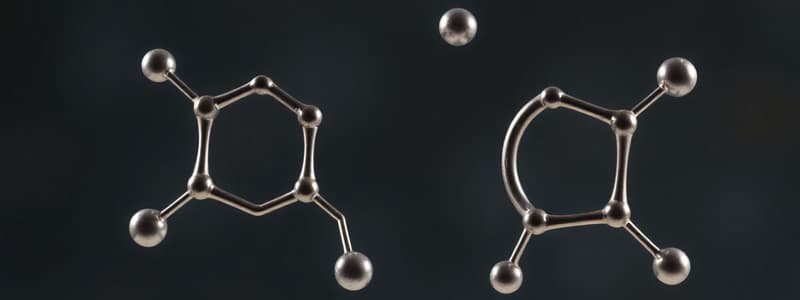Podcast
Questions and Answers
What primary force keeps the cation and anion together in an ionic bond?
What primary force keeps the cation and anion together in an ionic bond?
- Magnetic force
- Gravitational force
- Chemical bonding force
- Electrostatic force of attraction (correct)
Which property is NOT characteristic of ionic compounds?
Which property is NOT characteristic of ionic compounds?
- Malleability (correct)
- High melting and boiling points
- Electrical conductivity when dissolved
- Solubility in water
How do ionic compounds typically behave when struck?
How do ionic compounds typically behave when struck?
- They shatter (correct)
- They melt
- They flex and bend
- They break into powders
What ion does sodium (Na) form when it loses one electron?
What ion does sodium (Na) form when it loses one electron?
Which of the following ionic compounds is formed from magnesium and oxygen?
Which of the following ionic compounds is formed from magnesium and oxygen?
What type of lattice structure do ionic compounds typically form?
What type of lattice structure do ionic compounds typically form?
Why do ionic compounds generally have high melting points?
Why do ionic compounds generally have high melting points?
Which of the following ionic compounds can dissolve in water due to ionic bonds?
Which of the following ionic compounds can dissolve in water due to ionic bonds?
What ions do magnesium (Mg) form when it loses two electrons?
What ions do magnesium (Mg) form when it loses two electrons?
What is the role of electrolytes like sodium chloride in the human body?
What is the role of electrolytes like sodium chloride in the human body?
What happens to an atom when it forms a cation?
What happens to an atom when it forms a cation?
Which of the following correctly describes an anion?
Which of the following correctly describes an anion?
What is the primary driving force behind ionic bonding?
What is the primary driving force behind ionic bonding?
Which element is most likely to form an anion by gaining an electron?
Which element is most likely to form an anion by gaining an electron?
In the ionic compound formed between sodium and chlorine, how does sodium achieve a positive charge?
In the ionic compound formed between sodium and chlorine, how does sodium achieve a positive charge?
Which rule explains that atoms aim to have eight electrons in their outer shell?
Which rule explains that atoms aim to have eight electrons in their outer shell?
What type of bond is formed between cations and anions?
What type of bond is formed between cations and anions?
Which statement about the formation of ions is true?
Which statement about the formation of ions is true?
What characterizes ionic compounds structurally?
What characterizes ionic compounds structurally?
Which element is most likely to become a cation?
Which element is most likely to become a cation?
Flashcards are hidden until you start studying
Study Notes
Ionic Bonding Basics
- Ionic bonds form when atoms transfer electrons to achieve a stable electron configuration (usually 8 electrons in the outermost shell).
- Cations are positively charged ions formed when an atom loses electrons.
- Anions are negatively charged ions formed when an atom gains electrons.
- Electron Transfer Example: Sodium (Na) loses one electron to Chlorine (Cl), forming Na⁺ and Cl⁻ ions respectively.
How Ionic Bonds Form
- Ion Formation: Metals lose electrons to become cations and non-metals gain electrons to become anions.
- Ionic Bond Formation: Positively charged cations attract negatively charged anions due to electrostatic forces. This attraction forms an ionic bond.
- Ionic Compound Formation: Ionic compounds are electrically neutral, meaning the total positive charge from cations is balanced by the total negative charge from anions.
Properties of Ionic Compounds
- Physical Properties:
- High Melting and Boiling Points: Strong forces between ions require lots of energy to break.
- Hard and Brittle: Layers of ions can shift, causing repulsion between like charges, leading to shattering.
- Solubility in Water: Many ionic compounds dissolve in water because water molecules can surround and separate the ions.
- Electrical Conductivity: Conduct electricity when melted or dissolved in water due to free-moving ions.
- Chemical Properties:
- Crystalline Structure: Ions arrange in a repeating lattice pattern to maximize attraction and minimize repulsion.
- Reactivity: Ionic compounds can react with other substances to form new ionic compounds or molecular compounds.
Common Ionic Compounds
- Sodium Chloride (NaCl): Formed by Na losing one electron to Cl, forming Na⁺ and Cl⁻ ions. This compound is a common table salt.
- Magnesium Oxide (MgO): Formed by Mg losing two electrons to O, forming Mg²⁺ and O²⁻ ions. This compound is a common industrial ingredient.
- Calcium Carbonate (CaCO₃): Formed by Ca losing two electrons to the CO₃²⁻ ion (carbonate). This compound is found in rocks, shells, and pearls.
Importance of Ionic Bonds
- Biological Significance:
- Electrolyte Balance: Ionic compounds like NaCl are essential for maintaining electrolyte balance in the body regulating nerve and muscle function, hydration, and pH.
- Cell Membrane Function: Sodium and potassium ions play vital roles in maintaining cell membrane potential and facilitating nerve impulses.
- Industrial Applications:
- Salt Production: Sodium chloride is key in producing salt for various uses.
- Water Treatment: Ionic compounds are used to remove impurities and soften water.
- Ceramics and Glass: Ionic compounds like alumina (Al₂O₃) and silica (SiO₂) are used in ceramics and glass production.
Studying That Suits You
Use AI to generate personalized quizzes and flashcards to suit your learning preferences.



